The story of Midland's famous teen club from the 1960s
The Blue Light was an important mid-Michigan teen dance center that featured major rock and roll acts, many of the state’s important regional bands, as well as a host of young garage bands formed in the wake of the British Invasion. The venue was the brainchild of Hersh Goodwald: a chemical engineer, businessman, part-time disc jockey, and avid record collector, who formed a partnership with some other investors to buy a building and transform it into Midland, Michigan’s first, and most important, nightclub for young people.
Herman “Hersh” Goodwald was born on February 20, 1928, in Beaver County, Pennsylvania. He grew up in the industrial city of Rochester, located about 25 miles northwest of Pittsburgh. After graduating from Rochester High School, he joined the U. S. Marines and served in both World War II and the Korean War.
 Hersh Goodwald U.S. Marines
Hersh Goodwald U.S. Marines
Following his hitch in the Marines, Goodwald attended Geneva College in Beaver Falls, Pennsylvania, and graduated with a degree in chemical engineering. He joined Dow Chemical and, in 1961, moved with his wife Evelyn and young daughter Debbie to Midland, Michigan, to work at the company’s headquarters.
Mark Sanders was born in Midland and grew up on Townshend Street, about three blocks from the Knights of Columbus building on Ashman Street where he first came into contact with Hersh Goodwald. Sanders was a young musician who attended Midland High School, where he had formed a folk music group with some friends.
They were folk purists at that time, fans of Bob Dylan and Peter, Paul & Mary, who looked down on rock and roll; until the Beatles came along, that is. “The Beatles were a sea change. When we first heard I Want To Hold Your Hand on the radio that was it,” Sanders said. “That was what you wanted to be. Everybody loved them; every guy wanted to be them and every girl wanted to be with them; and here you are holding a guitar – what a nice coincidence.”
After buying a pickup for his 12-string acoustic guitar, Sanders started looking for other people to play in a band. Within a month or so, he had recruited Paige MacDonald, who lived down the block, to play drums and then traded his acoustic in for a Melody Maker electric guitar. Gradually, they found enough people to put the Rogues together. The group immediately gained a heap of prestige among their classmates during the 1964-65 school year by becoming the first rock band to play at Midland High. The Rogues appeared at the annual Rhapsody Rendezvous talent show and performed Boys, a Shirelles’ song that the Beatles had covered on their first album, and the kids went wild!  The Rogues: (L-R) Terry Dobson, Mark Sanders, Randy Markey
The Rogues: (L-R) Terry Dobson, Mark Sanders, Randy Markey
A couple of years after he arrived in Midland, Hersh Goodwald had begun running Saturday afternoon dances for teens at the K of C building on Ashman. Goodwald had done some DJ work back in Pennsylvania and had been a rock and roll fan since its earliest days.
Sanders, looking for a venue for the Rogues, walked up to Goodwald and asked if his band could play at one of his record hops. According to Sanders, “Hersh said, sure why not,” and it turned into a band gig for the Rogues every weekend. By this time, the Rogues had underwent a few personnel changes; and the band was now composed of Sanders on rhythm guitar, MacDonald on drums, Randy Markey on lead guitar, Bob Croope on organ, and Terry Dobson on bass guitar.
Sanders said this of Goodwald: “Hersh had an irreverent sense of humor, and he and the band hit it off immediately. He was older, but he was young at heart and into rock and roll before the Rogues were; and he liked early rockers like Jerry Lee Lewis and all of the doo wop groups. He had a big P.A. system, and because of his love of music, the Rogues asked him to become our manager. Hersh loved the idea, and he greatly enjoyed driving the band around to gigs in his Volkswagen bus,” Sanders said. “He took over the bookings for the band at the teen clubs in Michigan, including Band Canyon in Bay City and Daniel’s Den in Saginaw.”
Goodwald most likely got the idea for opening his own teen club after visiting the others in the area with the Rogues. In late 1965, he formed Teenco Inc., a business partnership with Eugene A. Collis, Robert S. Karpiuk, and Richard Waterman of Midland, along with Roy Sherman of Sanford, husband to Collis’ sister Shirley. Teenco then purchased the two-story K of C building and began remodeling it into a teen nightclub in mid-February of 1966. 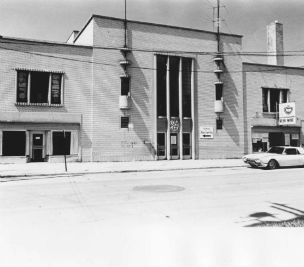 The Blue Light 1966
The Blue Light 1966
Mark Sanders, Randy Markey, and the rest of the Rogues were among the local teens who pitched in to help with the project. The main floor of the building had to be completely redesigned. The old bowling alley that featured live pinsetters had to be taken out. A stage, with a DJ booth, was built at the rear of the main floor; and it covered the entire width of the room. The stage was divided into a big one and a small one by curtains so that you could have continuous band music. They also built risers for tables and chairs that ran lengthwise on both sides so that teens had to step down to the dancefloor.
Entering the teen club, patrons first came into a lobby that featured a coat check and then through a doorway into the main floor where stood a tall marquee that featured posters and handbills announcing the bands that were playing, as well as advertising future performances. The entrance to the main floor was surrounded on either side by staircases leading to the upstairs room that had been converted into a game room with pool tables, and pinball machines. There was also a snack bar and soda fountain, and the music from the main floor was piped up to the upstairs area.
Goodwald generated a good deal of publicity for the new club by running a contest among area teens to come up with a name for the venue. Sanders’ suggestion was I Like It Like That, taken from the title of the Dave Clark Five’s hit single from 1965; but the winner was Blue Light, entered by a teenaged girl from Midland whose name has been lost over time. After the winning name was announced, Eugene Collis remembered that Teenco Inc. had the large white frosted light going up the steps to the game room painted blue to match the club’s new name.
Vickie (Schrock) Cox was one of the Midland teens excited about the new Blue Light teen dance club. She had been born in Saginaw but grew up in Bridgeport. At the age of eight, her family moved to Midland after her father was transferred by Michigan Bell. 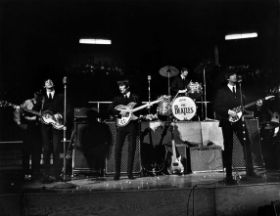 The Beatles at Olympia 1964
The Beatles at Olympia 1964
Although she liked rock and roll growing up, Vickie’s love of seeing the music performed live came at the age of 16 in 1964. She was one of the lucky few to win a ticket to see the Beatles at Olympia Stadium in Detroit through a contest run by DJs Bob Dyer and Dick Fabian of WKNX in Saginaw. Vickie fondly recalled the experience: “I won just the one ticket and had to earn the $5.00 to take the bus to Detroit and back. It included a box lunch. The radio station was providing the Greyhound bus for a group of fans to go see the Beatles’ concert.”
As you can well imagine, she had a ball at the show. Vickie had seen the Beatles on both the Jack Paar and Ed Sullivan TV programs; but the experience of actually being there in person to see the Fab Four, and to experience the excitement and music first hand, made for an unforgettable day. 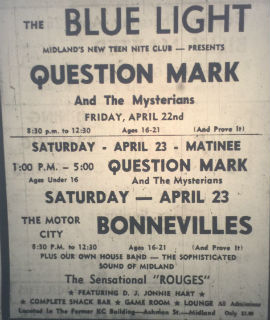 Blue Light ad Midland Daily News
Blue Light ad Midland Daily News
Vickie, like most teens in Midland, listened to WKNX and WSAM out of Saginaw, and Flint’s WTAC. Midland’s WMPX did not have a Top 40 format, and was strictly for adults. She remembered hearing the Blue Light being advertised on WKNX, and the band lineups for Fridays and Saturdays (and sometimes Tuesdays, Wednesdays, and Sundays) were printed each week in the Midland Daily News.
She attended Regina High in Midland, an all-girl Catholic school, and started going to the Blue Light during the spring of her junior year. Vickie went to the teen club regularly for the next 12 months. Since she lived on the other side of town, she would stay at her girlfriend’s house, who lived near the club, on the nights they planned to attend.
Vickie reflected on the Blue Light’s atmosphere over 50 years later: “We went to meet friends and to enjoy the music and the bands. It wasn’t really a dating scene; kids usually attended with a group. There was a lot of dancing when the DJ spun the records but not as much when the bands were playing. You could stand just a few feet from some of the biggest names on the charts, as well as young area bands who were just starting out.” 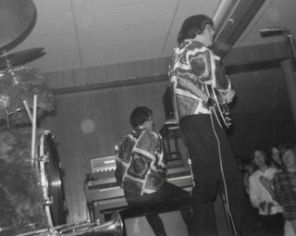 The Bossmen at the Blue Light (photo R. Markey)
The Bossmen at the Blue Light (photo R. Markey)
The Blue Light opened on Friday, March 25, 1966. The headliners were the Bossmen, led by Dick Wagner. The group was the hottest band in mid-Michigan after charting three consecutive singles on area radio stations, the latest being the two-sided hit Here’s Congratulations backed with Bad Girl.
Mark Sanders of the Rogues remembered the night clearly: “Opening night with us and the Bossmen was so packed that it was dampening the sound to the point that their small P.A. system couldn’t penetrate the crush of teens that was way over fire code," Sanders said. "I remember being in the back of the main floor, running wire the length of the building and putting speakers up on the marquee with Dick Wagner to try and improve the sound.”  Lyn & The Invaders (photo V. Cox)
Lyn & The Invaders (photo V. Cox)
The second night’s headliner on March 26th was Lyn & The Invaders from Grand Rapids, Michigan. Fronted by lead singer Lyn Nowicki, the band performed 10 shows at the Blue Light from their debut in 1966 to final appearance at the venue on February 10, 1967. Lyn & The Invaders’ first single, Boy Is Gone backed with Secretly, was recorded with Dave Kalmbach at the Great Lakes Recording Studio in Sparta, Michigan, and released on Fenton Records.
The first night Vickie (Schrock) Cox attended the Blue Light was the following weekend on April 2, 1966, when the New Colony Six appeared. The young Chicago band had a national hit earlier in the year with I Confess; and they previewed their newest single, I Lie Awake, which entered the Billboard chart two weeks later. 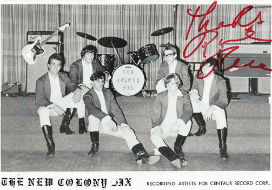 New Colony Six (photo V. Cox)
New Colony Six (photo V. Cox)
With the permission of Hersh Goodwald, Vickie collected a number of posters and handbills from the Blue Light, including one signed by the New Colony Six. She also took photographs of some of the bands that played there, including the Animals, Shadows of Knight, and the Kingsmen which she has preserved in a scrapbook. During that time, it was easy to talk to the artists, and Vickie collected autographs from many who played at the Blue Light.
? and the Mysterians perfortmed at the Blue Light for the first time on Friday night, April 22nd, and then returned the next day to play the Saturday afternoon matinee. The previous weekend, the band had recorded 96 Tears and Midnight Hour at the tiny Art Schiell Studio, located in the rear of his home on Raymond Street in Bay City. Their Blue Light show on Friday was probably the first time since the recording session that 96 Tears was played for a large audience. 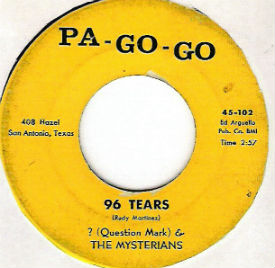 "96 Tears" was originally released on Pa-Go-Go
"96 Tears" was originally released on Pa-Go-Go
By the time of ? and the Mysterians’ next appearance at the Blue Light on Friday, May 27, 1966, the single had already been issued on Pa-Go-Go, a small San Antonio label; and 96 Tears was getting a lot of airplay on Saginaw’s two major AM stations, WKNX and WSAM. From there the song spread to WTAC in Flint and then on to Detroit where it also topped the charts.
After a deal was struck with Cameo-Parkway Records to distribute the single nationally, 96 Tears began its steady climb up the Billboard Hot 100 on September 3, 1966. 96 Tears went on to become one of the biggest hits of 1966, spending a total of 15 weeks on the Hot 100 and reaching # 1 on October 29, 1966.
The Rogues served as the house band for the Blue Light and played every weekend when the club first opened. They were a cover band playing hits of the day: Gloria, I Saw Her Standing There, and The Jolly Green Giant, along with other crowd favorites including: Louie Louie, Money, and Wipe Out.
Playing in the same venue week and week eventually led to Sander’s departure from the Rogues. “I got tired of playing in the same place to the same kids, week and after week,” he recalled. “It got to be kind of a grind for me, but the rest of the band seemed happy with it.” 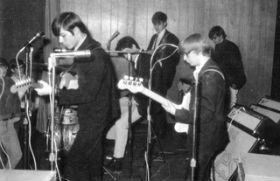 The Rogues at the Blue Light (photo R. Markey)
The Rogues at the Blue Light (photo R. Markey)
Rogues’ lead guitarist Randy Markey remembered how thrilling it was to open up for bands like the Animals, the Shadows of Knight, and the Kingsmen. “It was like being in a dream world,” Markey said. “Not only are you opening, but you’re backstage with them. You’re there when they pull up and bring their stuff in."
"The backstage had kind of an alley where the equipment could be rolled up and brought onto one of the stages. I remember meeting and hanging out with some of the guys in the bands, and I’ve got pictures of quite a few of them.” 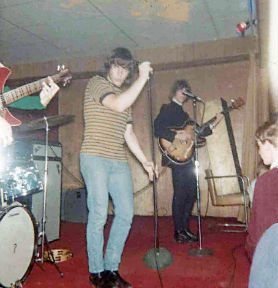 Shadows Of Knight (photo V. Cox)
Shadows Of Knight (photo V. Cox)
Markey also recalled the buzz of playing in a band at the Blue Light: “It was really exciting,” he said. “The stage was about 3 feet high and it had curtains. We usually set up on the stage to the left. The DJ would introduce the band and the curtains opened and you kicked off your set; and then the curtains closed when you finished. It was really something, especially coming from playing small parties to playing in a big building.”
Mark Sanders remembered that when the Shadows of Knight played two shows at the Blue Light on May 14, 1966, their recording of Gloria had just peaked at # 10 on Billboard’s Hot 100. The band had brought their ball gloves with them and played catch behind the building between performances. Sanders laughed when he recalled how he and the rest of the Rogues wondered about the funny smell coming from the Shadows of Knight’s dressing room.
He also remembered the Rogues opening for the Prime Movers at both the band’s matinee and evening performances at the Blue Light. The Prime Movers were a blues band from Ann Arbor led by Michael Erlewine, but its most famous member was its drummer, Jim “Iggy” Osterberg. Sanders said that the other members of the Prime Movers picked on Iggy the entire day, mercilessly teasing him about his effeminate walk and saying that he “moved like a girl.” 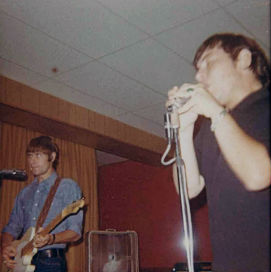 The Animals: Hilton Valentine and Eric Burdon (photo V. Cox)
The Animals: Hilton Valentine and Eric Burdon (photo V. Cox)
The most important band to perform at the Blue Light was the Animals. The English group, fronted by singer Eric Burdon, had placed ten hits in the Billboard Hot 100 starting with House Of The Rising Sun in the summer of 1964 through the band’s latest smash, Don’t Bring Me Down, which was still on the charts when they played two shows on Saturday, August 27, 1966.
Vickie (Schrock) Cox took some photos of the band that night. Vickie was even invited by the group’s manager to go to a party with the Animals, but being a good Catholic girl, she turned down the offer.
The Animals’ appearances at the Blue Light were significant because they were two of the final shows containing most of the group’s original members. The band broke up soon after, and Burdon would recruit a new lineup and record as Eric Burdon & The Animals for the next two years.  The Animals on stage (photo V. Cox)
The Animals on stage (photo V. Cox)
The Kingsmen were originally scheduled to play three shows at the Blue Light on Friday, January 27, 1967. Those shows were cancelled, and the make-up date was set for Thursday, February 23rd. Because it was a school night, the band’s three performances were scheduled one hour earlier at 8:00, 9:00, and 10 p.m. Although the Kingsmen were still very popular and were a model for many garage bands, they had already seen the last of the Hot 100. The band's final charting single was a cover of Killer Joe in 1966.
Terry Knight and the Pack made their second and final appearance at the Blue Light, headlining the venue’s special Vacation Dance on Thursday, March 30, 1967. The band had enjoyed four big regional hits with Better Man Than I, A Change Is On The Way, This Precious Time, and Love, Love, Love, Love; and they had broken into the Hot 100 for the first time earlier in 1967 with I (Who Have Nothing), which peaked at # 46. 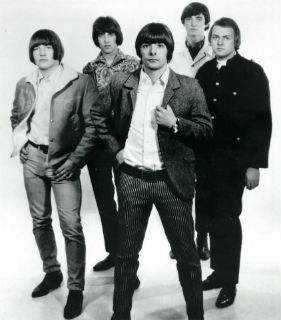 Terry Knight & The Pack
Terry Knight & The Pack
Knight would leave the band shortly after their appearance at the Blue Light to embark on a solo career. Pack members Mark Farner and Don Brewer kept the band going as the ‘Fabulous Pack’ after Knight’s departure; and they made their first appearance at the Blue Light under their new moniker on Wednesday, July 26, 1967.
Chicago’s Buckinghams had already scored a # 1 hit with Kind Of A Drag by the time they appeared at the Blue Light on Saturday, April 22, 1967. They were one of the country’s hottest bands, and the Buckinghams had placed two more songs on the Hot 100 by the time they came to Midland. The biggest of these was Don’t You Care, which would eventually rise to # 6 later in the spring. 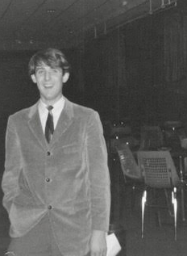 DJ Jonny Hart
DJ Jonny Hart
The Blue Light had a regular DJ who spun records before the bands played and again in between sets. The club’s first disc jockey was Jonny Hart. Vickie (Schrock) Cox remembered: “He was a good-looking guy and all the girls had crushes on him.” Randy Markey described Hart as: " a fun lovin' guy who always seemed to have a good time."
Mark Sanders remembered Hart less fondly, however: “Jonny Hart was a Northwood student who was very much into the girls who came to the Blue Light.” Sanders said. “He was a typical out-of-control college ladies’ man, and that was why he was in it; it wasn’t for the money or to become famous, he was there to get girls.”
Maybe because of that, or possibly to attract larger crowds with a big-name disc jockey; Hart was replaced in June of 1967 with Dick Fabian, the popular DJ from WKNX, mid-Michigan’s leading Top 40 AM radio station. Fabian would continue as the Blue Light's DJ until the venue closed in the summer of 1968.
Randy Markey recalled that Hersh Goodwald was always at the Blue Light. “Hersh was a young-at-heart guy,” Markey said. “He loved to dance with the girls at the club, and he would get out and shake it at every opportunity. Dancing was big when the Blue Light first opened. The kids always accepted him, even though he was much older,” he said. “It never seemed phony.” 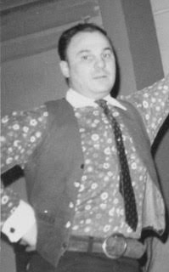 Hersh Goodwald at the Blue Light (photo R. Markey)
Hersh Goodwald at the Blue Light (photo R. Markey)
Sanders said after he left the Rogues, it was Hersh Goodwald’s idea to combine the remaining members with other musicians, to form a new seven-member band called the 7th Court. The band was unique in a couple of ways. They had two drummers and featured a segment called the “Duelin’ Drums” during their sets.
The band also wore medieval-styled band costumes (Sanders said they “looked like elf suits”) that set them apart from their contemporaries. The 7th Court made their Blue Light debut in the fall of 1966 by headlining at the club on Friday night, September 23rd and again for the matinee for younger fans on Saturday, September 24th.
Goodwald envisioned the 7th Court as a bigger touring band, complete with a renovated Greyhound bus to carry both the band and its equipment. The band then recorded a single at the Prophonic Studio in Mt. Morris, Michigan. The a-side of the 45 rpm single, released on Prophonics Studios label, was One Eyed Witch, a song composed by Hersh Goodwald. Randy Markey said that this first version of the 7th Court lasted until late 1967 or early 1968 when the band in Markey words: “got tired of Hersh wanting to run everything.” 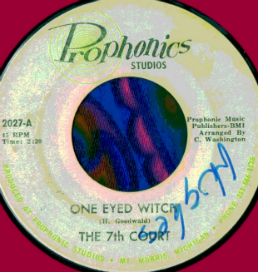 7th Court single
7th Court single
Markey would go on to join another band called Sand. The group would make its first appearance at the Blue Light on Saturday, January 13, 1968. Sand released a 45 in 1968 that was produced by Dick Wagner and issued on Wagner’s Dicto label.
By 1968, the Blue Light had dimmed considerably. It may have started as early as the summer of 1967 with the release of Sgt. Pepper’s Lonely Hearts Club Band by the Beatles and the rise of West Coast bands like the Doors and the Jefferson Airplane that heralded a change with music more geared to sitting and listening rather than dancing. The amount of money that could be generated by rock and roll was also beginning to affect the teen clubs, not just in Midland but all over the state.
During the Blue Light’s first year, the club hosted a number of national hitmakers; but by 1967, the smaller pay offered by the teen clubs made them unattractive to national acts who could make more money playing larger venues. In addition, the emergence of a drug scene, initially centered around marijuana, looked for music experiences that were not under the control and supervision of straight adults. As a result of these factors and others, it started to become less cool for young people to attend teen night clubs. 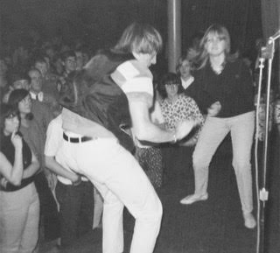 Dancing with the band (photo R. Markey)
Dancing with the band (photo R. Markey)
When the Blue Light first opened in March of 1966, the demand was so great that three and four-hour Saturday matinees, geared to younger music fans, were offered each weekend. Starting in June during summer vacation, the nights for fans under 16 were switched to Tuesdays from 7:30 to 10:30 p.m. In addition, the venue ran its own version of a battle of the bands, called the “Sound Spectacular”, on Sundays.
Once the school year started in the fall of 1966, the Blue Light returned to offering matinee shows on Saturday afternoons, but changed the admittance to “all ages” in an attempt to increase attendance. These were scrapped in November; and the venue was open only on Friday and Saturday nights, except for a handful of special dances, during the rest of the 1966-67 school year. 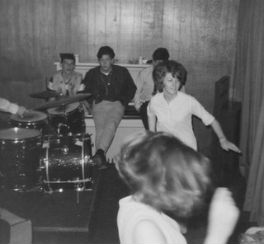 Dancing behind Blue Light's stage curtain
Dancing behind Blue Light's stage curtain
Starting on June 14th, the Blue Light returned to their Wednesdays and Saturdays summer schedule. This continued until August 11, 1967. From that night until the venue resumed its regular Friday and Saturday night schedule on September 15th, the Blue Light only advertised two dances.
The scheduled bands for the following year shows a definite lack of artists with national hits. The biggest name booked at the Blue Light from September of 1967 until July of 1968 was ? and the Mysterians. The legendary band of 96 Tears fame was already slipping, however, and no longer placing songs in the Hot 100 when they returned for the first of four appearances at the Blue Light on December 23, 1967. 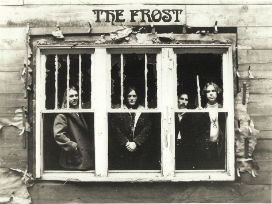 Dick Wagner opened the Blue Light in 1966 with The Bossmen and closed it in 1968 with The Frost
Dick Wagner opened the Blue Light in 1966 with The Bossmen and closed it in 1968 with The Frost
By the time ? and the Mysterians performed for the final time at the Blue Light on Saturday, May 18, 1968, the venue was open just one day per week. Although top quality Michigan bands like the Unrelated Segments, the Rationals, the Cherry Slush, the Fabulous Pack, the Scot Richard Case, and the Tidal Waves performed at the club in the spring and summer 1968, it was apparently not making enough money to keep the doors open. The Blue Light’s last advertised show was with Dick Wagner and the Frost on July 10, 1968.
From that point on, former Teenco partner Eugene Collis said that the Blue Light was rented out for wedding receptions and other weekend events. The upstairs game room and snack bar area was also rented as a dance studio. The last time that the Blue Light was listed in the Midland phone directory was in 1971, and the building was sold soon after. 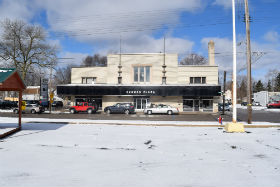 Ashman Plaza in Midland, Michigan
Ashman Plaza in Midland, Michigan
The building still stands today and is called the Ashman Plaza. The downstairs has been divided into several rooms for businesses including the Live Oak coffeehouse, Ashman Plaza Barbers, and Amy’s Hair Salon. The former game room and snack bar area is now called The Loft, and it shares space with the Captured Dance + Fitness Studio and the JW School of Dance.
The Blue Light existed during the golden age of garage bands; as Mark Sanders quipped, “Everyone wanted to be in a band and everybody was!” The venue certainly provided an opportunity for dozens of young bands to get up and prove themselves to a large audience of their peers, and also a nice place for young people to meet, dance, and enjoy the music. Although its time was relatively brief, the Blue Light lives on in the memories of those who were part of it.
The following dates and band listings were taken from the Blue Light’s weekly newspaper ads in the Midland Daily News. Evening dances were always for those 16 to 21, and they usually ran from 8:30 p.m. to 12:30 a.m. - unless otherwise noted. Matinees for those under 16 only lasted a few months and ran somewhere between 1:00 p.m. to 6:00 p.m. The matinees were later changed to include all ages.
Dates & Times Artist/s
Friday March 25, 1966, (evening) Bossmen, Rogues
Saturday March 26, 1966, (matinee) Rogues
Saturday March 26, 1966 (evening) Lyn & the Invaders
Friday April 1, 1966 Conclusions
Saturday April 2, 1966 (matinee) Rogues, Pharoahs
Saturday April 2, 1966 (evening) New Colony Six, Satisfactions
Friday April 8, 1966 Princeton’s (from Chicago)
Saturday April 9, 1966 (matinee) Montereys (from Detroit)
Saturday April 9, 1966 (evening) Montereys
Friday April 15, 1966 E.J. and the Echoes
Saturday April 16, 1966 (matinee) Prime Movers, Rogues
Saturday April 16, 1966 (evening) Prime Movers, Rogues
Friday April 22, 1966 ? and the Mysterians
Saturday April 23, 1966 (matinee) ? and the Mysterians
Saturday April 23, 1966 (evening) Motor City Bonnevilles, Rogues
Friday April 29, 1966 Town Criers
Saturday, April 30, 1966 (matinee) Debutantes
Saturday April 30, 1966 (evening) Debutantes
Sunday May 1, 1966, 2:00-6:00 p.m. Sound Spectacular 1 – winner: Empty Souls
Friday May 6, 1966 Satisfactions, Rogues
Saturday May 7, 1966 (matinee) Randy Knight and the Knightfighters, Rogues
Saturday May 7, 1966 (evening) Randy Knight and the Knightfighters, Rogues
Sunday May 8, 1966, 3:00-7:30 p.m. Sd. Spec. 2 – co-winners: Section 5, Empty Souls
Friday May 13, 1966 Conclusions
Saturday May 14, 1966, 4:00-8:00 p.m. Shadows Of Knight, Rogues
Saturday May 14, 1966, 8:30-12:30 p.m. Shadows Of Knight, Rogues
Sunday, May 15, 1966, 3:00-7:30 p.m. Sound Spectacular 3 – winner: Rebels
Friday May 20, 1966 Bossmen, Rebels
Saturday, May 21, 1966, 1:00-5:00 p.m. Lyn & the Invaders, Rogues
Saturday, May 21, 1966 (evening) Lyn & the Invaders, Rogues
Sunday May 22, 1966, 3:00-7:30 p.m. Sound Spectacular 4 – winner: Rebels
Friday May 27, 1966 ? and the Mysterians
Saturday May 28, 1966 (matinee) Rogues
Saturday May 28, (After Prom) 8:30-2:30 a.m. New Colony Six, Rogues
Sunday May 29, 1966, 3:00-7:30 p.m. Sound Spectacular Final – winner: Rebels
Friday June 3, 1966 Lassies (all girl from Kalamazoo), Rebels
Saturday June 4, 1966 (matinee) Lassies
Saturday June 4, 1966 (evening) Del-Rays
Friday June 10, 1966 Debutantes, Empty Souls
Saturday, June 11, 1966 (matinee) Debutantes, Empty Souls
Saturday June 11, 1966 (evening) Debutantes, Empty Souls
Friday June 17, 1966 Rationals, Rogues
Saturday June 18, 1966 (evening) Tempests, Rogues
Friday June 24, 1966 Lyn & The Invaders
Saturday June 25, 1966 (evening) Bed Of Roses
Tuesday June 28, 7:30-10:30 p.m. (under 16) Rebels
Friday July 8 Satisfactions
Saturday July 9, 1966 (evening) Warlocks
Tuesday July 12, 1966, 7:30-10:30 p.m. Trespassers
Friday, July 15, 1966 Conclusions
Saturday July 16, 1966 (evening) Rebels
Tuesday July 19, 1966, 7:30-10:30 p.m. Pharoahs
Friday July 22, 1966 Del-Rays
Saturday July 23, 1966 Del-Rays
Tuesday July 26, 1966, 7:30-10:30 p.m. Empty Souls
Friday July 29, 1966 Landeers
Saturday July 30, 1966 Trespassers
Tuesday August 2, 1966, 7:3-10:30 p.m. Rays Of The Rising Sun
Friday, August 5, 1966 Lyn & the Invaders
Saturday August 6, 1966 Lyn & the Invaders
Tuesday August 9, 1966, 7:30-10:30 p.m. Rebels
Friday August 12, 1966 Rationals
Saturday August 13, 1966 Coquettes (all girl from Battle Creek)
Tuesday August 16, 1966, 7:30-10:30 p.m. Section 5
Friday August 19, 1966 Jayhawkers
Saturday August 20, 1966 Paupers
Tuesday August 23, 1966, 7:30-10:30 p.m. Avengers
Friday August 26, 1966 Rebels
Saturday August 27, 1966, 7:00-10:00 p.m. Animals, Rogues
Saturday August 27, 1966, 10:30-1:30 a.m. Animals, Rogues
Tuesday August 30, 1966, 7:30-10:30 p.m. Empty Souls
Friday September 2, 1966 Jayhawkers
Saturday September 3, 1966 Paupers
Friday September 9, 1966 Lyn & the Invaders
Saturday September 10, 1966 (matinee) Talismen
Saturday September 10, 1966 (evening) Satisfactions
Friday September 16, 1966 Landeers
Saturday September 17, 1966 (matinee) Pharoahs
Saturday September 17, 1966 (evening) Bobby Rigg & the Chevelles
Friday September 23, 1966 7th Court
Saturday September 24, 1966 (matinee) 7th Court
Saturday September 24, 1966 (evening) Bossmen, Talismen
Friday September 30, 1966 Warlocks
Saturday October 1, 1966 (matinee) Conclusions
Saturday October 1, 1966 (evening Conclusions
Friday October 7, 1966 Morgues
Saturday October 8, 1966 (matinee) Outcasts
Saturday October 8, 1966 (evening) Escorts
Saturday October 15, 1966 (matinee) Section 5
Saturday October 15, 1966 (evening) Jayhawkers
Friday October 21, 1966 Bobby Rigg and the Chevelles
Saturday October 22, 1966 (matinee) Soul Searchers
Saturday October 22, 1966 (evening) Country Gentlemen
Friday October 28, 1966 Keystones
Saturday October 29, 1966 (matinee) Chargers
Saturday October 29, 1966 (evening) Terry Knight & the Pack, Soul Searchers
Friday November 4, 1966 Lyn & the Invaders
Saturday November 5, 1966 (matinee) Chalets (Indiana)
Saturday, November 5, (evening) Chalets
Friday November 11, 1966 Talismen
Saturday November 12, 1966 (matinee) Just Us
Saturday November 12, 1966 (evening) 7th Court
Friday November 18, 1966 Chancellors, Avengers
Saturday November 19, 1966 Excels
Thursday November 23, 1966 (Thanksgiving show) 7th Court
Friday November 24, 1966 Nomads
Saturday November 25, 1966 Jesters
Friday December 2, 1966 Motor City Bonnevilles
Saturday December 3, 1966 Frats
Friday December 9, 1966 Bobby Rigg & The Chevelles
Saturday December 4, 1966 Satisfactions
Friday December 16, 1966 7th Court
Saturday December 17, 1966 Landeers
Friday December 23, 1966 Ides of March
Wednesday December 28, 1966 7th Court
Friday December 30, 1966 Soul Survivor
Saturday December 31, 1966 Lyn & the Invaders
Friday January 6, 1967 Frut of the Loom
Saturday January 7, 1967 Montereys
Friday January 13, 1967 Count & the Colony, DJ Dick Fabian
Saturday January 14, 1967 Lorelies
Friday January 20, 1967 Warlocks
Saturday January 21, 1967 Satisfactions
Friday January 27, 1967 Kingsmen 3 shows (cancelled)
Friday February 3, 1967 Talismen
Saturday February 4, 1967 Dimensions
Friday February 10, 1967 Lyn & the Invaders
Saturday February 11, 1967 Chalets
Friday February 17, 1967 Landeers
Saturday February 18, 1967 Paupers
Thursday February 23, 1967 Kingsmen (makeup date) 3 shows
Friday February 24, 1967 Law
Saturday February 25, 1967 Bells Of Rhymny
Friday March 3, 1967 Nick & the Disciples
Saturday March 4, 1967 Next Exits
Friday March 10, 1967 Ides of March
Saturday March 11, 1967 Satisfactions
Friday March 17, 1967 Intruders
Saturday March 18, 1967 Talismen
Friday March 24, 1967 Only Four
Saturday March 25, 1967 Frut of the Loom
Tuesday March 28, 1967 (Anniversary dance) Satisfactions
Thursday March 30, 1967 (Vacation dance) Terry Knight & the Pack
Friday April 7, 1967 March Hares
Saturday Aril 8, 1967 Dimensions
Friday April 14, 1967 Bean Machine
Saturday April 15, 1967 Count & the Colony
Friday April 21, 1967 Soul Searchers
Saturday April 22, 1967 Buckinghams
Friday April 28, 1967 Section 5
Saturday April 29, 1967 Landeers
Friday May 5, 1967 Talismen
Saturday May 6, 1967 Motor City Bonnevilles
Friday May 12, 1967 Rainmakers
Saturday May 13, 1967 Bean Machine
Friday May 19, 1967 Karavan
Saturday May 20, 1967 Paupers
Friday May 26, 1967 Ides of March
Saturday May 27, 1967 Night Raiders
Monday May 29th, 1967 (Holiday dance) Nick & the Disciples
Friday June 2, 1967 Morgues
Saturday June 3, 1967 Next Exit Blues Band
Friday June 9, 1967 Count and the Colony
Saturday June 10, 1967 Poor Souls
Wednesday June 14, 1967 Karavan, Bach Inc.
Friday June 16, 1967 Rainmakers
Wednesday June 28, 1967 Talismen
Friday June 30, 1967 Intruders
Wednesday July 5, 1967 Paupers
Friday July 7, 1967 Frut of the Loom
Wednesday July 12, 1967 Excels
Friday July 14, 1967 Merseyside Sound
Wednesday July 19, 1967 Jayhawkers
Friday July 21, 1967 Landeers
Wednesday July 26, 1967 Fabulous Pack
Friday July 28, 1967 Ides of March
Wednesday August 2, 1967 Bossmen
Friday August 11, 1967 Bossmen
Friday September 1, 1967 Section 5
Saturday September 9, 1967 Count & the Colony
Friday September 15, 1967 Rainmakers
Saturday September 16, 1967 Landeers
Friday September 22, 1967 Sayme
Saturday September 23, 1967 Paupers
Friday September 29, 1967 Extreme Middle
Saturday September 30, 1967 Bach Inc.
Friday October 6, 1967 Midnight Shift
Saturday October 7, 1967 Vicars of Wakefield
Friday October 13, 1967 Conspiracy
Saturday October 14, 1967 Innsmen (Detroit)
Friday October 20, 1967 Karavan
Saturday October 21, 1967 Suns of Sound
Friday October 27, 1967 Cherry Slush
Saturday October 28, 1967 Merseyside Sound
Friday November 3, 1967 New Ides of March
Saturday November 4, 1967 Contraptions
Friday November 10, 1967 Ones
Saturday November 11, 1967 Innsmen
Friday November 17, 1967 Bach Inc.
Saturday November 18, 1967 Avengers
Wednesday November 22 (Thanksgiving Eve dance) Rumors
Friday December 1, 1967 Dick Wagner and the Frost
Saturday December 2, 1967 Frut of the Loom
Friday December 8, 1967 Cinnamon Vine
Saturday December 9, 1967 Count & the Colony
Friday December 15, 1967 Liberators
Saturday December 16, 1967 Dick Wagner and the Frost
Friday December 22, 1967 Merseyside Sound
Saturday December 23, 1967 ? and the Mysterians, Count & the Colony
Wednesday December 27, 1967 Dick Wagner and the Frost
Friday December 29, 1967 Shepherd and the Flock
Saturday December 30, 1967 Sayme
Friday January 5, 1968 New Ides of March
Saturday January 6, 1968 ? and the Mysterians, Count & the Colony
Friday January 12, 1968 Endless Chain
Saturday January 13, 1968 Sand
Friday January 19, 1968 Acid Factory
Saturday January 20, 1968 Disraeli Gears
Friday January 26, 1968 Paupers
Saturday January 27, 1968 Unrelated Segments
Friday February 2, 1968 Runarounds
Saturday February 3, 1968 Amboy Dukes
Friday February 9, 1968 Sayme
Saturday February 10, 1968 Rumors
Friday February 16, 1967 Liberators
Saturday February 17, 1968 Jayhawkers
Friday February 23, 1968 Sand
Saturday February 24, 1968 Rainmakers
Friday March 1, 1968 Merseyside Sound
Saturday March 2, 1968 Tidal Waves
Friday March 8, 1968 Vicars of Wakefield
Saturday March 9, 1968 Rationals
Friday March 15, 1968 Federation
Saturday March 16, 1968 ? and the Mysterians
Friday March 22, 1968 Innsmen
Saturday March 23, 1968 Fabulous Pack
Wednesday March 27, 1968 Scot Richard Case
Saturday March 30, 1968 Sand
Saturday April 6, 1968 Unrelated Segments
Saturday April 13, 1968 Landeers
Saturday April 20, 1968 Girls, Incorportated (Detroit)
Saturday April 27, 1968 Rumors
Saturday May 4, 1968 Cherry Slush
Saturday May 11, 1968 Tidal Waves
Saturday May 18, 1968 ? and the Mysterians
Friday May 24, 1968 Emeralds, New Breeds, Souel Inc.
Saturday May 25, 1968 Merseyside Sound
Saturday June 8, 1968 Flock
Wednesday June 19, 1968 Cherry Slush
Wednesday June 26, 1968 Rationals
Wednesday July 3, 1968 Wax Radish
Wednesday July 10, 1968 Dick Wagner and the Frost

